Radiosailing Takes Off with DragonFlite 95 at Nantucket Race Week 2020
By Tom Darling
This piece brings you something old and something brand new, but both right in line with the sailing history of their day. In the deep summer of COVID, I stumbled into a mega-trend of sailors trying to figure out how to have fun with boats in the age of masks, social distancing, and PODS. It is sailing gone “small.” Bring your beach chair, and plenty of AA batteries. Let’s go model yachting, born in the late 1880s as “miniature yacht racing,” grown up as “radio-controlled sailing” or “R/C,” and now updated in 2020 as “Radiosailing.”
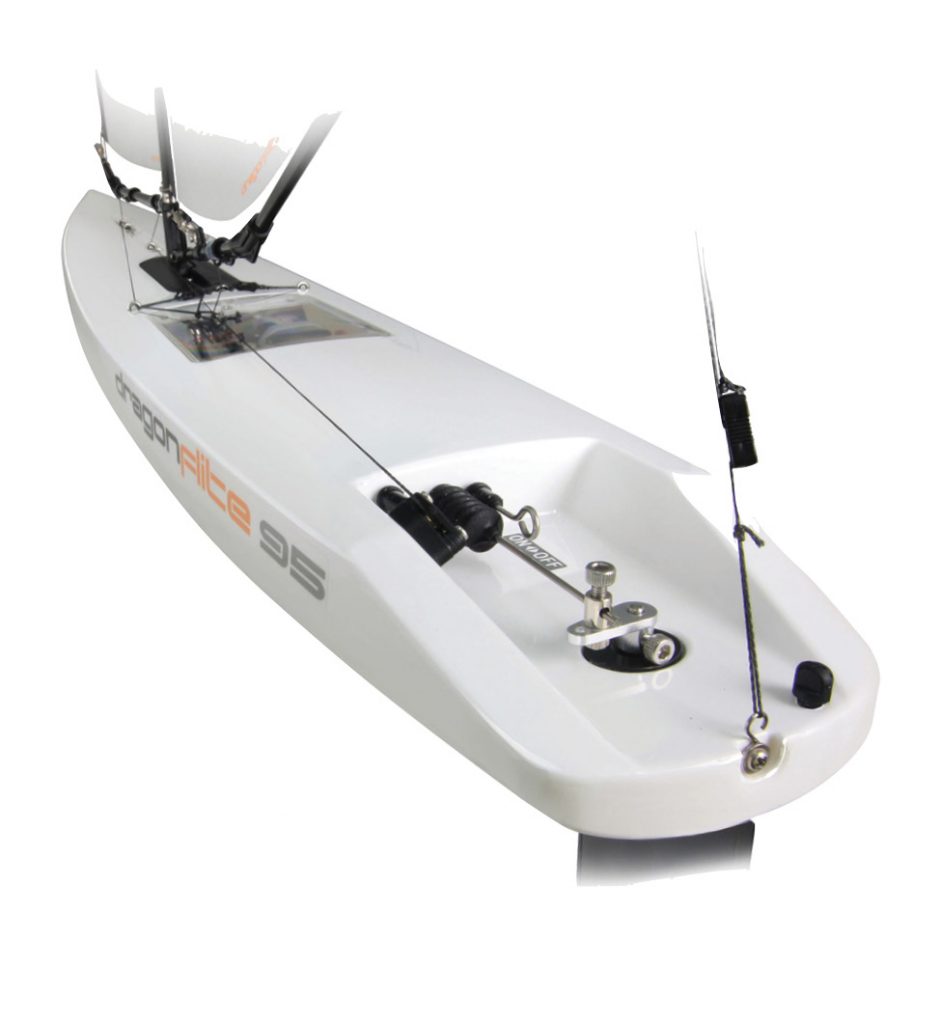
Just under a meter in length with sophisticated carbon spars and racing controls, the DragonFlite 95 is a high performance boat in a box. © radiosailing.net
We met our first model racing ace online, a retired big boat sailor speaking from his Florida kitchen, and the next one in South Africa, via YouTube. Radiosailing could be the most international, collaborative flavor of sailing on the planet. We see Mr. Florida Big Boat, deeply tanned, with his radiosailing boat on its stand on his kitchen table. That’s the new thing: Kitchen Table Sailing.
Will future sailors will look back at the Summer of ‘20, 101 years after the Spanish Flu of 1918-‘19 and say, “The new thing was radiosailing, way back in the summer of the Great Lockdown”? Transport yourself back to the Gilded Age, those heady days of captains of industry racing their naptha launches to Wall Street and backing syndicates for monstrous America’s Cup boats. For most people, the recreational craze was bicycling. Biking was fundamental to the newest leap of technology, flying. Think about it: the Wright Brothers started in a bike shop.* After the biking craze and before the Roaring Twenties, there was yachting and there was boating. Yachting was still a richer man’s sport.
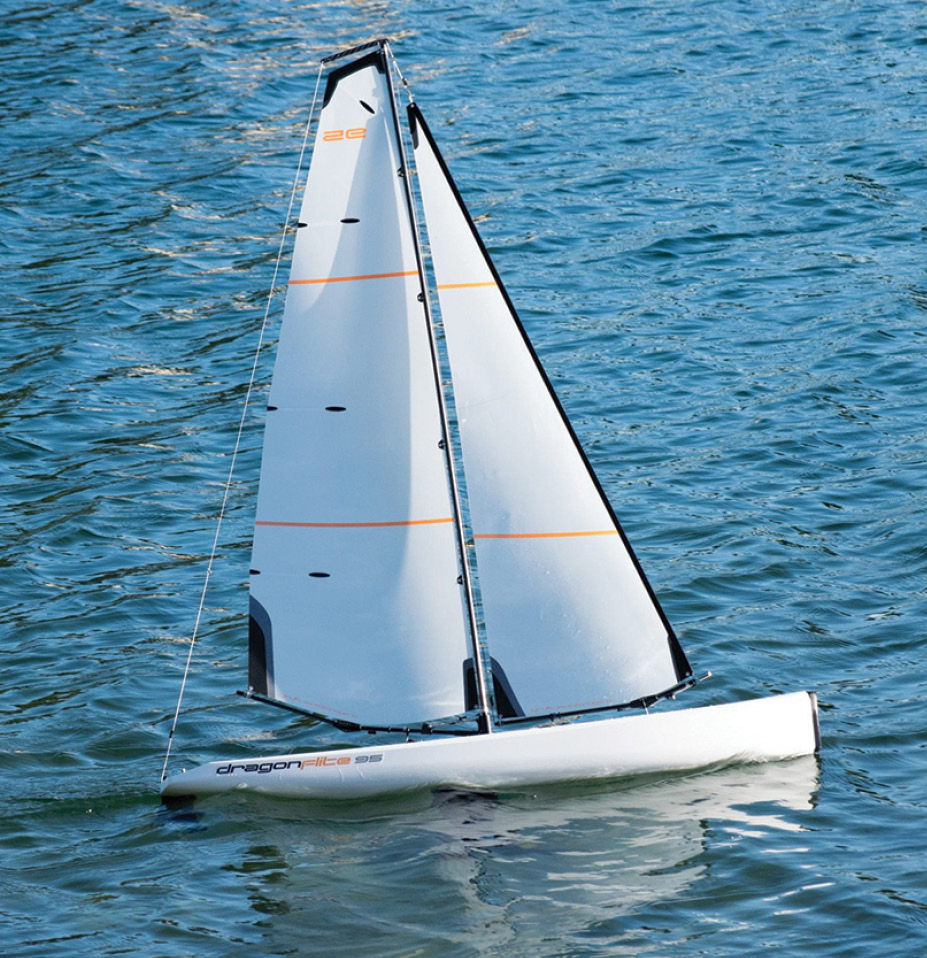
Like a miniature TP52 with rockered bow and the ability to plane, the DF-95 is a pocket rocket. © radiosailing.net
But there was another, more democratic form of boating. That was miniature yacht sailing and that was for everyone. Fathers and sons built their model sailboats, be they pond yachts carved out of a spare piece of wood or sophisticated plank-on-frame beauties constructed to the new International Rule. And they took to any bit of flat water that would float a boat. There were model boat clubs far and wide. One only had to walk off New York’s 5th Avenue at 72nd Street and peer over the wall and there was the Central Park YC, circa 1907.
Models served some very practical purposes. On one hand, they were built to demonstrate designs and get a client’s approval for the final, full-scale build. There were no test tanks in 1900: a builder made a model of his design and sailed it to see how it performed. When you, the new yacht owner, paid the bill, you ended up with your boat and your sailing model.
The sailing middle class went model yachting for recreation on urban ponds and watercourses. The equipment (putting aside the radio controls that would not arrive until the 1970s) has remained the same for the new model yachting: A boat you can carry, a stand to put it on, a long stick, say bamboo, with a pad at the end to jab the boat away from the pond edge, a sponge to empty the hull and a good tool kit…and the time for fiddling.
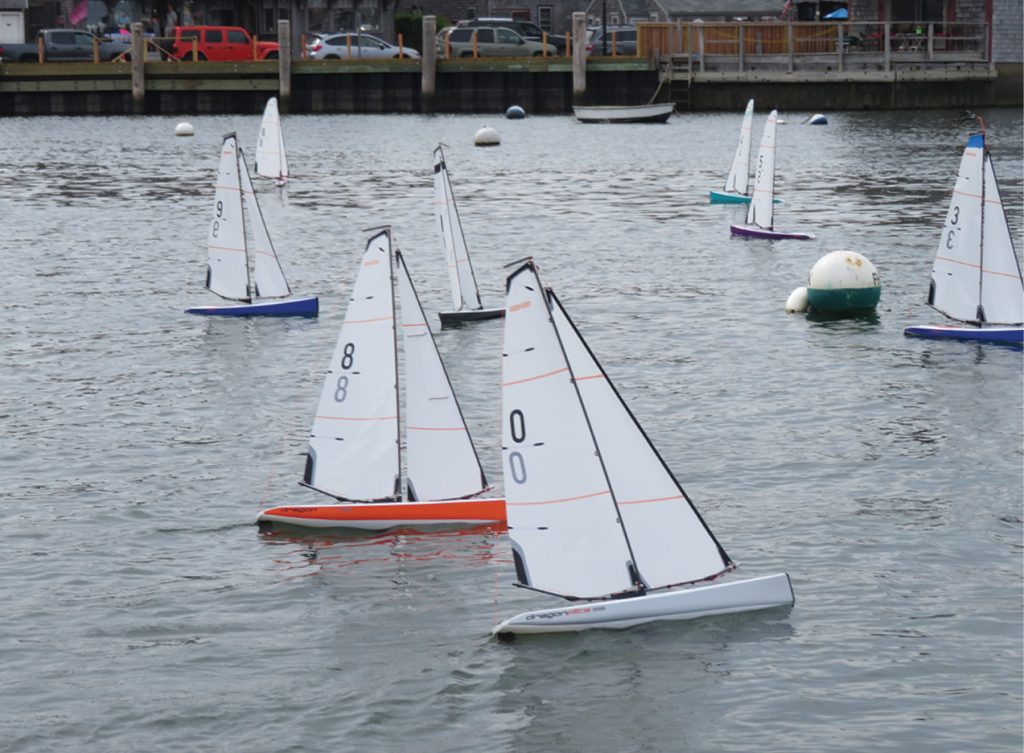
Pre-start maneuvers in Nantucket’s first radiosailing regatta © Ned Darling
The rationale for modern radiosailing, amplified in our topsy-turvy world, tells you where the roots of model boating have gone. There are good reasons for its growth. Seniors get to keep sailing competitively. Juniors get to joust with their well-honed video gaming skills and try out racing tactics with their buddies. And all of us get to be on the water – six feet apart and masked –joysticks in our hands, helming handsome vessels at a popular price. It’s what sailing has always been, at its best. What is the ultimate proof of this genre’s acceptance? The rules of model racing are now codified at the end of The Racing Rules of Sailing. Radiosailing has arrived; most of us just don’t know it.
We went back in my own family’s sailing history to delve into miniature yachts, a pastime of sailors as old as man and his first toy boat on a pond or a stream. And we went forward to play our own part in the newest event in radiosailing on the historic island, in the Great Harbor of the island of Nantucket, thirty-five miles out to sea. Podcasters can hear it all on Conversations with Classic Boats. There, you the listener will experience radiosailing with a live audio stream of Nantucket Community Sailing’s Radiosailing Regatta for DragonFlite 95s. It’s all at conversationswithclassicboats.com.
And as we are accustomed, we go back in yachting time. What is the history of our topic, model yachting, the granddaddy of today’s radiosailing? This history is a very personal one for me. Most of my sailing life I have had on my bookshelf an oversize linen book with a creaky binding. On that binding it says, Miniature Racing Yachts by Thomas Darling.
Not me – the author was my great uncle, an industrial arts teacher in the Bronx Vocational High School. He taught students how to build boats. By night, he was a draftsman for naval architects, Clinton Crane being the best known. That was in 1935 in the heart of the Depression, but in my great uncle’s book the message is clear: have a great time playing with model boats when you may or may not have access to their bigger cousins.
Born on City Island, New York, my Uncle Tom grew up in New Rochelle and was a water rat. In all the old Brownie pictures of him from the box under the bed, he is either sailing or getting on or off a boat. Much of it was solo sailing. Uncle T was our family’s Captain Nat with just a touch of Captain Jack Sparrow. On the Conversations for Classic Boats website, you can see his model legacy in pictures of my brother’s and my model R boats. Mine is called Wave. The book pictures include Bubbles, my brother’s twin model, sailing on a pond in Westchester. Gaze on them, fifty-six inches long, graceful swans with gleaming white hulls, blue bottoms, and delicately planked decks. The monster Reliance model at the Herreshoff Marine Museum in Bristol, Rhode Island is roughly three and a half times larger.
These early 20th century models, built before the J Boats arrived for the America’s Cup, were constructed by one of three methods. The Table of Contents for Miniature Racing Yachts, published in 1935, outlines those alternatives for the model yacht builder:
Chapter II: Building a Hull by the Solid Block Method Remember Capt. Nat and his omnipresent half model in hand, whittling and fairing design history from a block of wood? He went on to take measurements with his caliper contraption to translate form to paper. (Go back and listen to Episode 2 to hear more on the Herreshoff Method.)
Chapter III: Building a Hull by the Lift or Bread and Butter Method of Construction This is described as the method commonly used when making half models for the use of naval architects and ship builders. Take a series of long rectangular wood shapes, glue them together, put it all in a vise and start scraping. Eventually, Voila, half a hull. Repeat on the other side for the other side and glue the two halves together. Pretty common this was for the more sophisticated models of the early 20th century, with hundreds of half models and many miniature yachts built this way.
Then finally in Chapter IV of Miniature Racing Yachts, we come to our own family’s boat building methodology: Building a Hull by the Rib-Frame and Plank Method of Construction This was my model Wave’s birthright. Employ a backbone or keel, ribs, frames or timbers and planking to form the skin and the deck. Leaving the intricacies of planking aside, there being many patterns, suffice it to say the result is pure boat, fair and true. The offset tables (remember the Mystery of the Missing Offsets in Episode 2 on the Alerion design?) tell the story of how the final lines will turn out. Remember the Herreshoff Method? My great uncle built the same upside down way.
A later chapter in the book discusses spar building. The last chapter, How to Make Fittings, covers all of the hardware suitable on a “modern racing miniature.” As with Capt. Nat in Bristol, modeling is a case of backward integration, on a 1 to 10 scale. Each boat has a web of very little lines connected to a tiny piece of hardware, the name of which we believe will stump all modern yachtsmen not immersed in model yachting. And that word is “Bowser,” better known to modelers as “Bowsie.” The explanation for this crucial crossword puzzle term in an online citation says: “Bowsers are used to regulate the lengths of sheets and halyard.” Huh? It is the hardware equivalent of a bowline or a cleat. All model boats are rigged and controlled with this oval of metal through which the little lines go.
I remember in high school trying to find authentic vintage hardware to launch my boat in the local pond. Rigging was handmade. I remember a shop in Brooklyn Heights. An older Norwegian gentleman, downstairs in a brownstone, had himself a fantasyland of small metal parts, spreaders, shrouds, and turnbuckles. It was like the Santa’s Workshop of miniature yachting. This was fifty years ago. That spot in the Heights is now a Starbucks.
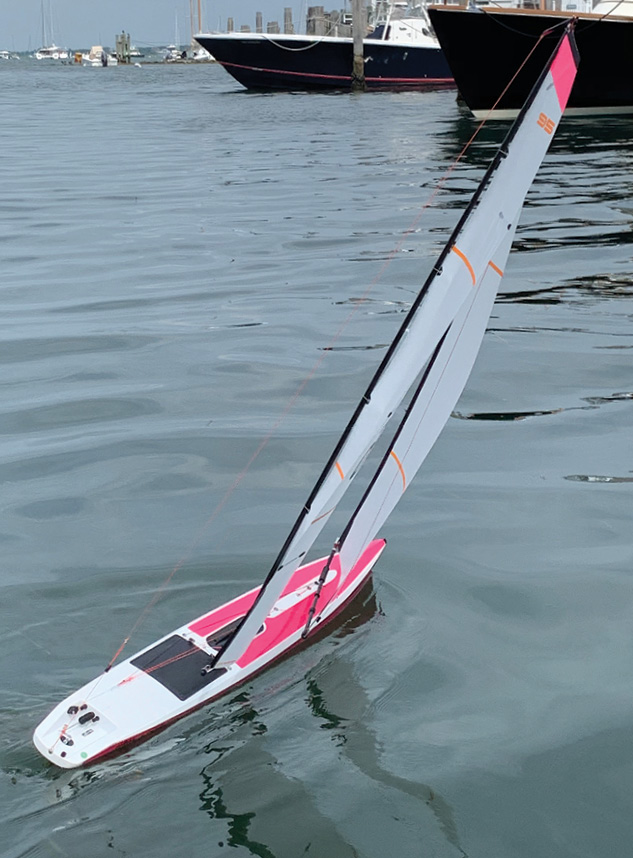
Brian Simmons’ Pink Panther on the course © Ned Darling
The construction of Bubbles and Wave is oak frames planked with white cedar. They weighed twenty-five pounds without the rig. You moved them with a handle inside on the keel. Put the rig on and carry it to water, and adjust the “bowsies,” those round, self-cleating fixtures. In the water they go and fifty-six inches of classic model take off across the water. It was really a two-man game: one to watch, and to anticipate the path and be ready to fend off from the shoreline. It’s hard for me to imagine these boats racing in a fleet, but they did (with rubber bow bumpers) in Playland Lake in Rye, New York.
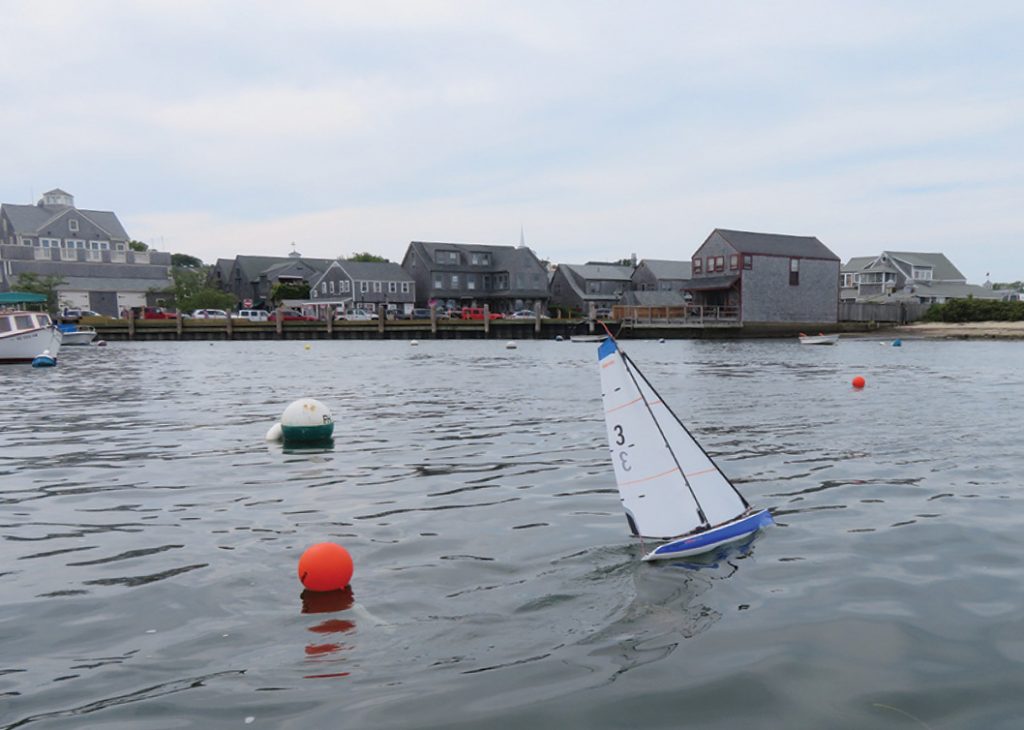
Major supporters of Nantucket Race Week 2020 received a shiny new DF-95 in the color of their choice. At press time, there were twenty boats in Nantucket’s New Rainbow Fleet. © Ned Darling
Now, what of this radiosailing in 2020? Some colorful characters, including a number of icons in the boating industry, have developed a fascination with miniature yacht racing. One such character is Bob Johnstone, now of Charleston, South Carolina. THE Bob Johnstone, who founded J Boats with his younger brother Rod, in a garage in Stonington, Connecticut. They were the godfathers of the line of boats that in the late 1970s revolutionized the competitive sailing scene of our time. It was the J/24 that drew the hot intercollegiate sailors and created the ecosystem for the growth and excellence of U.S. one-design keelboats in the last 40 years.
Bob is a born salesman, with a career in marketing at Quaker Oats and then AMF – the bowling company with the boat business called Alcort, maker of the Sunfish. He is enthusiasm with a capital “E.” In a phone call, Bob gave the backstory of how he came to build a thriving radiosailing fleet in a pond behind his senior community. When he moved to Charleston, he was looking for one-design sailing. He acquired a Soling Class replica, but couldn’t find others to sail against. He saw a certain sleek looking boat on YouTube and called the distributor in Texas.
The boat is the DragonFlite DF-95, imported from Donguan, China by Radiosailing.net, the brainchild of Chuck LeMahiu, the only boat dealer I have ever heard start a conversation with “Howdy!” From his office in the Dallas suburbs, Chuck has spent the last decade marketing a line of lightweight model sailboats from a designer in the UK, John Vishingham. Starting with a 650 millimeter lightweight sloop, the DF-65 made by Joysway, a Chinese manufacturer of radio controlled cars, he has moved up over the last three years to sell over 4,000 units (15,000 sold worldwide) of the almost a meter-long craft called the DragonFlite DF-95. Checking it at 950 millimeters LOA (38 inches for us North Americans), only five pounds with a sophisticated set of carbon spars and racing controls, a bulbed carbon fiber keel 40 % in depth compared to the boat’s length, the DF-95 is a pocket rocket. Think of a TP52 with rockered bow and the ability to plane. It is a performance miniature yacht, far from the sleek planked leadmine my uncle tinkered with.
Bob Johnstone’s answer to fleet development was to order a mess of DF-95s from Chuck, offer them to his sailing neighbors and even put them together for sailing on a pond contiguous to the senior community. He publishes a detailed cheat sheet on how to rig and operate the DF-95. “When I started, it took me nine hours to put a boat together,” said Bob. “We have it down to about four.” Bob has grown the fleet by leaps and bounds, with so many boats on the pond that they have 10 am and 4 pm sittings for the racing…competitors must stay sitting in their chairs six feet apart! “We’re up to seventeen boats,” he enthused, “and we have a backlog of people who want in.”
The Charleston DF-95 Fleet has struck a chord with racing sailors denied their normal competition by CV-19. Bob hit the nail on the head: a sophisticated model – not a toy – capable of being assembled in a day or less, transportable in an SUV, and fun sailing with natural social distancing (masks optional but generally encouraged).
All of this is just right for our strange times. DF-95 fleets are popping up in the hottest sailing venues, including Newport where three clubs aggregate over forty boats including twenty acquired by Brad Read, Executive Director of Sail Newport, for junior sailing, and Marblehead, with a dozen piloted by local pros including Bill Lynn, President & Executive Director of the Herreshoff Marine Museum.
We now move to my home waters, Nantucket, where Diana Brown, Chief Executive of Nantucket Community Sailing (NCS), was trying to figure out how to put on a COVID Race Week. Limitations on crew size, distancing and other restrictions seemed to eliminate most of the week’s traditional events.
Aside from the financial implications of having an empty Nantucket Harbor the second week of August, the NCS leadership needed a contingency plan to inspire sailors for Race Week 2020.
Enter Carolyn Grant Zarella, former Director of Aailing at the Great Harbor YC’s Jobson Sailing Center. Carolyn had been given a large Marblehead model, really an imitation J Boat, years back to audition for senior and junior sailors. Mostly it looked elegant sitting on a stand inside the club. The search was on for a radiosailing class for Nantucket’s flat water, mooring-clogged Great Harbor.
As with Bob Johnstone, Caroline’s web surfing yielded the DF-95 as the modern option for a radiosailing event in Nantucket Harbor. Answering the phone was that same CEO of Radiosailing.net in McKinney, Texas, Chuck, the driving force in what I call the “boat in a box” movement in radiosailing. An ingenious scheme to match major donors to their very own DF-95 in the color of their choice found the first order of twelve sold out in no time.
When the boxes arrived in the Great Hall of Nantucket’s Egan Institute on Winter Street, home of Nantucket Community Sailing, everyone gulped. “How do we put them together?” A local model enthusiast, Mitch Carl, jumped in and the boats stood ready to be selected by their skippers more than a week before the August 14 regatta. The colorful hulls reminded me of Nantucket’s historic Rainbow fleet, immortalized in 1930 in the work of local artist William Gardner when he created a set of postcards featuring a fleet of small catboats with colored sails. Most of the sailing world calls them Beetlecats, but are they are known as Rainbows on Nantucket.
Now we witnessed the second coming, the New Rainbow Fleet, with magic marker-colored sails, masthead color matching the hulls in order to pick out a boat in a crowd. The difference is in the steering: today’s model is controlled with a handheld console more familiar to the teen participants than their parents. One joystick for the deep carbon rudder, the other for the linked Mylar main and jib attached to carbon fiber spars with truly teeny fittings. Inside the hull a miniature winch trims the sails, linked to the controls by small servos and powered by a battery pack the size of a 9-volt battery.
Imagine this scene: Race Day, 4 pm on an August Friday on a stretch of 110 linear feet of lawn adjoining the North Wharf Cottages, quaint modern reproductions of fishermens’ shacks in downtown Nantucket. The sailors are divided into twelve zones, six feet apart, all participants in masks, beverage sponsorship from the local Cisco Brewery. With boats tuned and on stands, contestants listen intently to the first set of sailing instructions for model yachting any of them have ever seen. There is the frisson of something new: “Contestants, start your boats!” DragonFlites turn on with a button on the rear deck.
What does a radiosailing course look like? The idea is to have as many races as possible. A racecourse is 100 yards top mark to offset down to the leeward gate with the start/finish line in the middle. An average race is six to eight minutes. The rules are liberal: “Do no harm” is Rule #1. Logjams at marks are common. It is all in good humor.
The PRO, Chuck Allen from North Sails in Portsmouth, Rhode Island, deftly uses both loudhailer and a starting sequence run from an iPhone through a Bose Bluetooth speaker for the one-minute dinghy starts. Slipped in the water off finger piers and bulkheads, the fleet has a few practice races before Chuck signals the first of ten races. It is immediately clear that a few sailors are either ringers or have done it before. It is also evident that the major problem for sailors is beneath the water: eelgrass. The DF-95’s deep blades are grass-catchers. Watery vegetation and mooring lines are the fleet’s archenemy.
But the major hazard for model yachting is operator error. Collisions result often but at low speeds. The DF-95s are incredibly responsive upwind and down. They easily overtack. But downwind, with the jib wung out, the trip from windward mark to leeward gate can be under two minutes. The racers’ excitement builds. With a handful of minor breakdowns, sailors try to keep their boats out on the course with frequent trips to the pit crews on the bulkheads. No Ford v. Ferrari here: the most common fault is a loose battery connection. The #6 boat smokes; the pit crew confers.
As the event unfolds, the skippers start leaving their assigned posts and finding any vantage point for a better radio signal. Soon there are sailors on docks, boat decks, anywhere for line of sight. We watch it all from an inflatable charged with dropping marks and rescuing eelgrass victims. Social distancing protocol is challenged by the desire to get the best possible signal.
After ten races there is a clear winner, with local businessman and Nantucket Indian sailor Alan Worden and his son Henry, winning six. We learn later that Alan spends his winter radiosailing. One-design Fleet Captain Skip Willauer, a Rhodes 19 ace who sails the DF-95 in Vero Beach, Florida in the winter, was a pre-race betting favorite, and took second. By my eye, the age of the two brothers who finished third might have averaged 12; the younger one was 9.
This is sailing at its best, absorbing, intergenerational, fast-paced, and technically absorbing. The response of the participants was wildly enthusiastic. We pulled the boats at 5:30 pm as agreed and participants walked away with commemorative trophies bearing the NCS logo and Nantucket’s iconic scallop shell. Nantucket Regatta 2020 is in the books and a 2021 reprise is assured.
Another eight boats have been ordered, bringing Nantucket’s DF-95 total to a lucky twenty. Instant fleet development has paid off, and we expect not only that there will be a 2021 Nantucket Regatta for Radiosailing, but also a lot more “New Rainbows” on the line. ■
Tom Darling organizes Team Dolphin for its annual Opera House Cup sail, and sails Alerions in Nantucket Harbor. He has written articles on Reliance and Dolphin, among other Herreshoff boats. You’ll find his excellent “Conversations with Classic Boats” podcast at conversationswithclassicboats.com.
* As folks born and raised in Bridgeport, Connecticut will affirm, the world’s first powered flights were achieved by Gustave Whitehead, who launched the airplane he built from a hillside in nearby Fairfield and flew several miles over Long Island Sound…more than two years before the Wright Brothers. – Ed.
